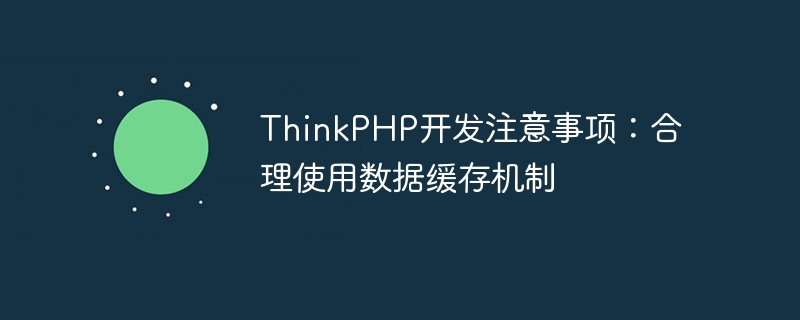

ThinkPHP is a popular PHP development framework with a powerful data caching mechanism and flexible cache configuration. Proper use of data caching mechanisms is crucial to developing efficient and stable applications. This article will discuss the precautions for reasonable use of data caching in ThinkPHP development.
1. The role of caching
In web applications, data caching is an important means to improve performance and response speed. Through caching, frequently accessed data can be stored in memory or other fast-access storage media, reducing the number of database accesses, speeding up data reading, and improving system performance and stability.
In ThinkPHP, the data cache can store database query results, page fragments, configuration information, etc. Proper use of data caching can effectively reduce database load and improve system throughput.
2. Choose the appropriate cache driver
ThinkPHP provides a variety of cache drivers, including File, Redis, Memcached, etc. When choosing a cache driver, you need to consider the actual needs and characteristics of your system.
If the application is deployed in a stand-alone environment, you can choose File cache as the cache driver, which is simple and easy to use without installing additional software. If it is a distributed system, you can choose Redis or Memcached as the cache driver, which supports distributed deployment and can provide higher performance and availability.
In addition, for large-scale data caching requirements, you can consider using distributed caching solutions, such as Redis Cluster or Memcached cluster, to meet the needs of high concurrency and large-scale data access.
3. Cache Management
In ThinkPHP, cache can be managed through functions such as cache tags and cache elimination strategies. Proper use of these functions can improve cache utilization and hit rates and reduce resource waste.
For example, you can set different cache tags for different types of data, or set cache expiration time to ensure timely updating and effective utilization of cached data. In addition, by monitoring the cache hit rate and failure rate, the cache configuration can be adjusted in time to optimize system performance.
4. Cache and database synchronization
In actual application development, we often encounter the problem of cache failure after data update. To avoid data consistency issues, database updates and cache synchronization need to be handled properly.
ThinkPHP provides a variety of cache operation methods, such as cache writing, updating and deleting, etc. When data is updated, the corresponding cache data needs to be updated in a timely manner to maintain data consistency. You can realize automated processing of database operations and cache synchronization by listening to database operation events or customizing hook methods.
In addition, you can consider using technical means such as cache preheating and cache asynchronous update to improve system performance and data synchronization efficiency.
5. Cache security
When using data caching, you need to pay attention to the security of the cache. Reasonable caching policies and permission control can effectively prevent security risks such as cache injection and cache penetration.
For example, sensitive data can be protected from malicious tampering and access through cache permission control, cache data encryption and other means. In addition, for cache injection attacks, risks can be prevented through checksum filtering of legitimate cache key values.
In short, reasonable use of the data caching mechanism can improve system performance, reduce database load, and enhance system stability. In ThinkPHP development, developers need to comprehensively consider application characteristics, actual needs and caching mechanisms, and conduct reasonable cache design and use based on actual scenarios to achieve efficient and stable web applications.
The above is the detailed content of ThinkPHP development notes: Proper use of data caching mechanism. For more information, please follow other related articles on the PHP Chinese website!
 Which one is easier, thinkphp or laravel?
Which one is easier, thinkphp or laravel?
 How is the performance of thinkphp?
How is the performance of thinkphp?
 What causes the computer screen to turn yellow?
What causes the computer screen to turn yellow?
 How to solve the problem of dns server not responding
How to solve the problem of dns server not responding
 The role of Serverlet in Java
The role of Serverlet in Java
 array_push
array_push
 nginx restart
nginx restart
 What are the C language programming software?
What are the C language programming software?
 China Bitcoin Trading Platform
China Bitcoin Trading Platform